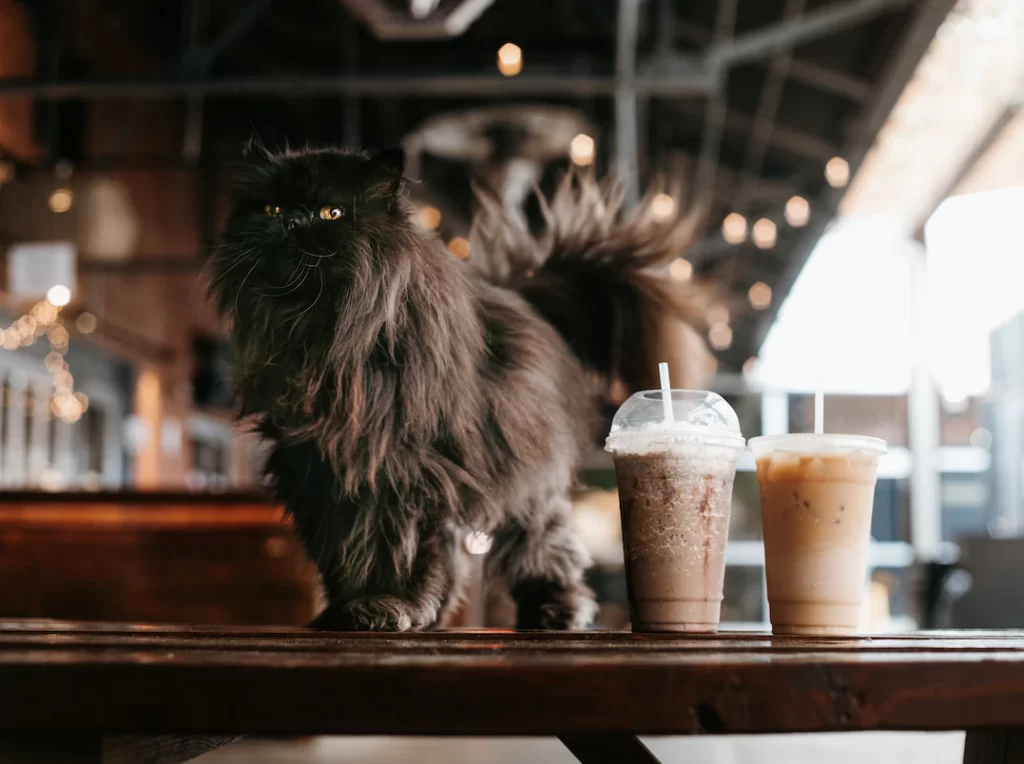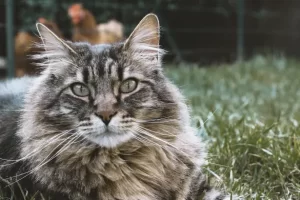Last updated on February 6th, 2023 at 03:33 am

Can cats drink chocolate milk? The answer is simple, they can only have very small amounts of chocolate milk but it is more advisable to not give them any chocolate drink. When a cat drinks a lot of chocolate milk, the caffeine, sugar, and cocoa powder in it can kill it. Since the 1960s, cartoons, movies, picture books, and other forms of media have spread the image of a cat licking a bowl of milk.
Most cats seem to like milk, so most people think it’s safe to give their cat milk. Since your furball seems very interested in your chocolate milk, you give in and let it try it. But if you’ve never had a pet before, you might wonder if it’s safe for yours. How much do you think it’s a good idea to feed your cat milk, if at all? Is it bad for a cat to drink a lot of milk? Let’s find out together!
Is milk harmful to cats?
Before we go further, let’s answer it in general first. Is milk harmful to cats? To answer your question, an adult cat can consume milk. Even though cats don’t have any trouble drinking milk, that doesn’t mean they should. Cattle milk is fine for cats once in a while, but they shouldn’t drink it every day. Even though milk is creamy, some adult cats may be able to drink and digest it. A snack that seems harmless to you can give your cat terrible stomach problems.
Some cats have trouble digesting lactose, which is a sugar found in milk. Kittens have an enzyme called lactase that helps them digest their mother’s milk. Kittens can digest lactose when they are young, but as they get older, their bodies make less lactase, and they are no longer able to do so. Pet MD says that cats shouldn’t have access to milk because it has a lot of lactose, but small amounts of cheese won’t hurt them. If you have to hide a pill in cheese, watch for signs that your cat is having stomach trouble. Now, let’s go to Chocolate Milk.
Is it true that chocolate milk may kill cats?
It is widely accepted that cats should not drink chocolate milk. Chocolate milk has a reasonable amount of chocolate. Theobromine, a component in chocolate, can induce heart difficulties in cats, leading to death. This can occur whether you feed your feline companion a large amount of chocolate or just a small piece. Chocolate milk contains sugar and lactose, which may cause Gastrointestinal Upset in your cat. As a result, it will take a long time for your cat to acquire a serious sickness. More like a slow painful death.
Baking chocolate and dark chocolate are two varieties of chocolate that are even more toxic to your cat. Chocolate that has been heavily diluted is substantially safer than other types of chocolate. As a result, you shouldn’t worry about your cat being unwell from drinking chocolate milk on its own. Instead, you should be concerned about the long-term effects of chocolate milk on their health.
Good reasons why kittens shouldn’t drink chocolate milk
While it’s common knowledge at this point that you shouldn’t give your cat chocolate milk, there are still plenty of individuals who aren’t aware of just how harmful the beverage can be. Here are five reasons why cats shouldn’t drink chocolate milk and what could go wrong if you do give it to them.
There is a risk of poisoning from eating chocolate
Cats who have access to or eat chocolate run the risk of developing chocolate poisoning. Ingesting too much chocolate can make your cat sick, but a little bit won’t hurt them. However, milk chocolate is the worst of the bunch and can cause a lot of problems; excessive consumption can have devastating effects.
Caffeine is also present in chocolate. This could cause your cat to become hyperactive and vomit. Caffeine has a stimulating impact on people, increasing heart rate, blood pressure, and urine production, making it harder for your cat’s kidneys to handle the excess fluids passing through its system.
Inability to digest lactose
The vast majority of cats are lactose intolerant. It is advisable to avoid giving your cat dairy products. Cats do not require milk after they have been weaned from their mother’s breast milk. A mother cat would only need to create enough milk for her new infant when her kittens are weaned at about 8 weeks, rather than the energy-producing milk for an older cat.
If you offer your cats lactose-free or conventional chocolate milk, it will overwhelm their system with something they don’t need, leading to diarrhea and a stinky litter box! Chocolate milk can have an even greater impact on their systems since their bodies stop manufacturing an enzyme that breaks down milk and all the sugar it contains.
Negative symptoms
Being lactose intolerant causes unpleasant symptoms. The symptoms might range from modest, such as increased thirst, to moderate, including vomiting, diarrhea, bloating, restlessness, and hyperactivity. As well as more severe symptoms including shaking, stiffness, convulsions, a racing heart, and even death. Although it may not seem serious at first, consuming too much chocolate milk can be fatal.
The problem of becoming overweight
Chocolate milk does not have the same nutritional value as cat food. Chocolate milk has many more calories per cup, which could throw your cat’s nutrition off balance and contribute to obesity. Sugar and calories can be found in milk on their own. Milk chocolate has an even higher sugar content and calorie count. Regular cow’s milk with 2% fat has 12 grams (4 teaspoons) of sugar; whole cow’s milk with 3% fat contains 15 grams of sugar (5 teaspoons). A cup of semi-sweet dark chocolate has 19 grams of sugar (6 teaspoons) by itself! This means that a can can contain up to 36 grams (12 teaspoons) of sugar.
Obesity is a common problem among cats whose owners feed them chocolate milk on a regular basis. They’re hooked not on the chocolate taste, but on the milk fat. They have a strong craving for cream-based foods like ice cream and whipped cream, but they should avoid these because of their lactose intolerance. Diabetes, high blood pressure, coronary disease, and even cancer have all been linked to obesity.
Safety
We must take good care of our pets because they are more than just animals to us; they are members of our families. The compounds contained in chocolate milk cannot be properly broken down by a cat’s liver. When individuals consume too much fructose, their bodies are unable to convert it to glucose due to a deficiency of fructokinase.
Never let cats develop an addiction to milk; they’ll keep asking for it, and we won’t be able to say no, even though we know it’s unhealthy for them. When it comes to your cat’s chocolate milk addiction, it’s best to be safe than sorry.
How toxic is chocolate milk to cats?
There is no certain amount that can be dangerous because all cats are different; some can suffer while showing no signs. Not only cats are lactose intolerant, but chocolate has poisonous ingredients that might be harmful to them. Drinking chocolate milk can poison them. Depending on the brand, chocolate milk contains cocoa and syrup, raising the sugar content.
Chocolate milk includes theobromine, a poisonous chemical that can be harmful to pets when used as a milk substitute. The amount taken depends on the cat, but if the mildest symptoms arise, go to the clinic right away because it can lead to the worst symptoms. Even if your cat hasn’t shown any of the symptoms and responds well to chocolate milk, don’t take the chance.
What happens if I give my cat chocolate milk?
If your cats drink chocolate milk, the worst that can happen is diarrhea. Chocolate milk is the least damaging kind of chocolate that cats can consume because it includes the least amount of sugar and caffeine compared to most other cocoa products.
Cats also lack alkaline phosphatase, which aids in the breakdown of good foods into nutrients and energy that the body requires to function properly. Because feline kidneys are not designed to digest such large amounts of chocolate milk as human kidneys, drinking too much chocolate milk may result in vomiting or diarrhea, which makes sense when you consider how we can’t safely drink that much chocolate milk either.
What you must do is keep a tight eye on your feline companion after she has ingested chocolate milk. There should be no concerns if she does not vomit or have diarrhea. However, if you believe it may cause an issue, you should check with your veterinarian right away.
What should you do if your cats drink chocolate milk?
Chocolate milk is by far the safest chocolate for cats. However, it is critical to remain vigilant and follow basic guidelines. First and foremost, if you detect that your cats drink chocolate milk, keep a close eye on the cat to see if any symptoms emerge. Keep the cat indoors and don’t allow it out.
If you are concerned, contact your veterinarian straight away; if you reach them soon after they ingest it, they can induce vomiting and eliminate all of the toxicity of chocolate from their system. It’s also critical that you know everything there is to know about your cats, such as its weight and size; this will help the vet decide what to do.
Assume your vet diagnoses your cat with chocolate toxicity. In such a scenario, once you get your cat home, it’s critical to keep them hydrated and on a restricted diet following treatment and to always follow the vet’s advice.
Are there any chocolate milk substitutes?
Cats should be provided with nothing but water in general. The normal cat only requires a full bowl of fresh water to be hydrated. Cats would naturally obtain the majority of their moisture from their food. Cats in captivity, on the other hand, may not acquire enough moisture if they eat dry food. Furthermore, certain felines may require more water due to medical issues. More water, for example, can often prevent urinary tract infections.
If your cat requires additional nourishment, it is generally advised to supplement its diet with more wet food. Water flavorings can also be added to your cat’s water to encourage them to drink it. However, this is not always essential. Here’s a more detailed explanation.
Water
To put it simply, you can’t go wrong with water: it has no calories, costs next to nothing, and is perfectly safe. As a result, if you want to offer your cat anything to quench its thirst, give it water. A conventional bowl should suffice most of the time, however, some felines may prefer to drink from running water. As a result, it’s a good idea to invest in a couple of cat fountains to guarantee that the pets have adequate water. Such things are available at reasonable prices in pet stores nowadays.
Canned Tuna
As previously stated, cats must obtain much-needed nutrients by digesting animal tissues. As a result, it’s a good idea to treat your furball to some tuna every now and then. Tuna treats provide protein, minerals, vitamins, antioxidants, and other nutrients to cats, which is beneficial. Furthermore, tuna contains fewer calories than milk, making it unlikely that your pet would get obese. Nonetheless, pet owners should keep things under check by giving tuna snacks to their cats at specified periods.
Wet Foods
Though wet foods lag behind dry foods in several ways, they are often excellent substitutes for milk. Cats, especially sluggish ones who don’t drink enough water, have no trouble staying hydrated throughout the day because of the moisture in wet foods. Furthermore, the varied flavor of wet foods typically allows you to use them in your pet’s everyday meals as well as occasional treats. Assuming you understand the ingredients, your fluffy companion should be able to stay in shape.
Can Cats Drink Other Kinds of Milk?
Cats are famously finicky creatures. This is something we are all aware of. They dislike change, have certain eating patterns, and become agitated when you try to pet them on the head or stomach. What about milk, though? Is drinking cow’s milk safe for cats? If not cow’s milk, what other types of milk may a cat consume?
Yes, the answer is yes! Cats can consume the following milk: kitten milk substitute, soy, almond, rice, and goat’s milk. Now I’ll go over the benefits of each type of milk in greater detail, as well as how much water your cat should drink each day to stay hydrated while consuming different types of milk.
Kitten Milk Substitute
Milk is vital for kittens that are still too young to start eating solid foods. Many kittens do not obtain milk from their moms, and they require special formulas to grow well. KMR is the best milk to give to kittens that are still nursing.
Soy Milk
If your cat is allergic to dairy, soy milk may be beneficial. Because soy milk contains no lactose, it can help with gastrointestinal problems that cats may have after drinking ordinary cow’s milk. However, there are more reasons why soy milk is good for cats:
- It contains omega-3 fatty acids, which aid with brain function and cardiovascular health.
- It aids in the maintenance of a healthy weight by suppressing hunger.
- It contains calcium, which helps to maintain strong bones and teeth.
There are many different kinds of soy milk on the market nowadays, so choose one that doesn’t have any added sugar or artificial flavors. Cats can thrive on a diet consisting solely of soy milk, but excessive consumption can result in diarrhea.
Almond Milk
Almonds include vitamin E, which is a powerful antioxidant that can help your pet’s immune system and heart health. It’s abundant in vitamin D, which promotes bone health and can alleviate arthritis symptoms. It also contains omega-3 fatty acids, which are essential for your cat’s skin and coat.
Rice Milk
Rice milk contains a lot of potassium, which is beneficial for the heart and helps with muscular function. Rice milk contains no lactose, making it an excellent choice for those who are lactose intolerant or allergic to cow’s milk products. It is also higher in calcium than almond or soy milk. However, rice milk is still not the best option because of its high sugar, but still better than chocolate milk.
Goat Milk
It turns out that cats prefer goat’s milk to cow’s milk for a variety of reasons. Cats have trouble digesting lactose; goat’s milk contains 30% less lactose than cow’s milk and is gentler on the stomach (hence why some people who are allergic to dairy also do not experience any symptoms from consuming goat products). The calcium content of goat’s milk can also assist prevent tooth decay and iron absorption. Cow’s milk contains more casein protein than goat’s milk, but goat’s milk contains more whey protein.
Conclusion
Cats cannot drink chocolate milk, and consuming too much sugar or lactose in their diet might cause major health problems. If you want to give your feline companion something sweet, try canned tuna or salmon mixed with water instead of milk! Remember that sugar is also poisonous to cats. A little won’t hurt, but in the long run, it can lead to liver failure. It may appear to be a harmless treat, but chocolate may be quite hazardous to our animal friends if consumed!


